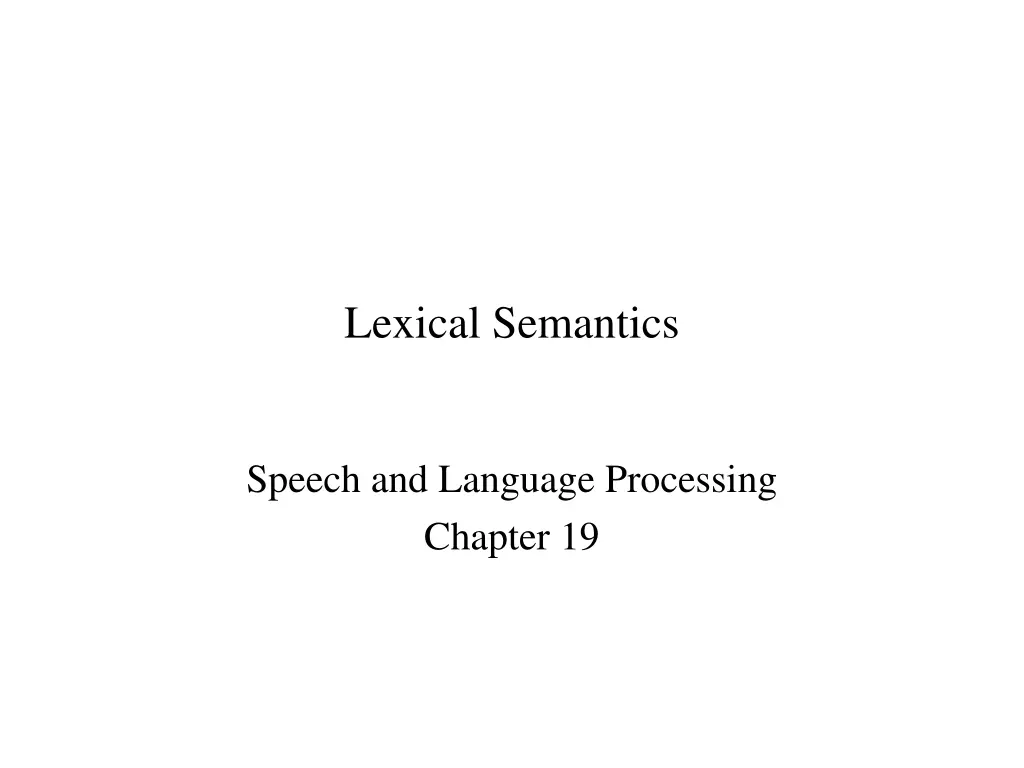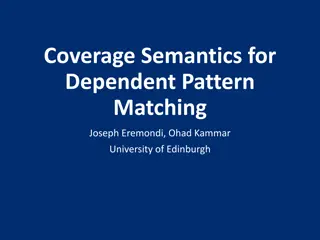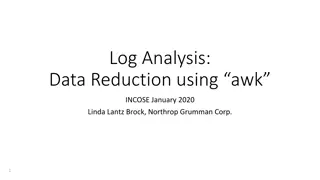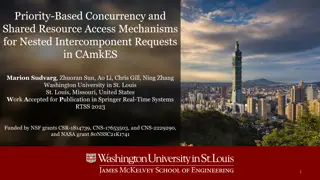Lexical Semantics
Delve into the intricacies of word meanings, from basic definitions like lexeme and lexicon to possible word relations such as homonymy, polysemy, synonymy, and more. Understand how words combine to form sentences and how their meanings contribute to discourse analysis.
Download Presentation

Please find below an Image/Link to download the presentation.
The content on the website is provided AS IS for your information and personal use only. It may not be sold, licensed, or shared on other websites without obtaining consent from the author. Download presentation by click this link. If you encounter any issues during the download, it is possible that the publisher has removed the file from their server.
E N D
Presentation Transcript
Lexical Semantics Speech and Language Processing Chapter 19
Three Perspectives on Meaning 1. Lexical Semantics The meanings of individual words Formal Semantics (or Compositional Semantics or Sentential Semantics) How those meanings combine to make meanings for individual sentences or utterances (see skipped chapters) Discourse or Pragmatics How those meanings combine with each other and with other facts about various kinds of context to make meanings for a text or discourse Dialog or Conversation is often lumped together with Discourse 2. 3.
Sidebar: Compositional Semantic Analysis Applies principle of compositionality Links semantic attachments to syntactic rules Incrementally ties semantics to parse processing Lambda calculus meaning representations Most complexity pushed into lexical items
Today Introduction to Lexical Semantics Homonymy, Polysemy, Synonymy, and more Semantic Roles Online Resources
Lexical Semantics Focus on word meanings: Relations of meaning among words Similarities & differences of meaning in sim context Internal meaning structure of words Basic internal units combine for meaning
Word Definitions What s a word? Definitions so far: Types, tokens, stems, roots, inflected forms, etc... Lexeme: An entry in a lexicon consisting of a pairing of a form with a single meaning representation Lexicon: A collection of lexemes
Possible Word Relations Homonymy Polysemy Synonymy Antonymy Hypernomy Hyponomy Meronomy
Homonymy Lexemes share a form Phonological, orthographic or both But have unrelated, distinct meanings Clear examples Bat (wooden stick-like thing) vs. bat (flying scary mammal thing) Bank (financial institution) versus bank (riverside) Can be homophones, homographs: Homophones: Write/right, piece/peace, to/too/two Homographs: Desert/desert Bass/bass
Issues for NLP Applications Text-to-Speech Same orthographic form but different phonological form bass vs. bass Information retrieval Different meanings same orthographic form QUERY: bat care Machine Translation Speech recognition
Polysemy The bank is constructed from red brick I withdrew the money from the bank Are these the same sense? Different? Or consider the following WSJ example While some banks furnish sperm only to married women, others are less restrictive Which sense of bank is this? Is it distinct from the river bank sense? The savings bank sense?
Polysemy A single lexeme with multiple related meanings (bank the building, bank the financial institution) Most non-rare words have multiple meanings Number of meanings related to word frequency Verbs tend more to polysemy Distinguishing polysemy from homonymy isn t always easy (or necessary)
Metaphor vs. Metonymy Metaphor: two different meaning domains are related Citibank claimed it was misrepresented. Corporation as person Metonymy: use of one aspect of a concept to refer to other aspects of entity or to entity itself The Citibank is on the corner of Main and State. Building stands for organization
How Do We Identify Words with Multiple Senses? ATIS examples Which flights serve breakfast? Does America West serve Philadelphia? The zeugma test: conjoin two potentially similar/dissimilar senses ?Does United serve breakfast and San Jose? Does United serve breakfast and lunch?
Synonymy Word that have the same meaning in some or all contexts. filbert / hazelnut couch / sofa big / large automobile / car vomit / throw up Water / H20 Two lexemes are synonyms if they can be successfully substituted for each other in all situations If so they have the same propositional meaning
Few Examples of Perfect Synonymy Even if many aspects of meaning are identical Still may not preserve the acceptability based on notions of politeness, slang, register, genre, etc. E.g, water and H20, coffee and java
Terminology Lemmas and wordforms A lexeme is an abstract pairing of meaning and form A lemma or citation form is the grammatical form that is used to represent a lexeme. Carpet is the lemma for carpets Specific surface forms carpets, sung are called wordforms The lemma bank has two senses: Instead, a bank can hold the investments in a custodial account in the client s name. But as agriculture burgeons on the east bank, the river will shrink even more. A sense is a discrete representation of one aspect of the meaning of a word
Synonymy Relates Senses not Words Consider big and large Are they synonyms? How big is that plane? Would I be flying on a large or a small plane? How about: Miss Nelson, for instance, became a kind of big sister to Benjamin. ?Miss Nelson, for instance, became a kind of large sister to Benjamin. Why? big has a sense that means being older, or grown up large lacks this sense
Antonyms Senses that are opposites with respect to one feature of their meaning Otherwise, they are very similar dark / light short / long hot / cold up / down in / out More formally: antonyms can Define a binary opposition or an attribute at opposite ends of a scale (long/short, fast/slow) Be reversives: rise/fall, up/down
Hyponyms A sense is a hyponym of another if the first sense is more specific, denoting a subclass of the other car is a hyponym of vehicle dog is a hyponym of animal mango is a hyponym of fruit Conversely vehicle is a hypernym/superordinate of car animal is a hypernym of dog fruit is a hypernym of mango superordinate vehicle fruit furniture mammal hyponym car mango chair dog
Hypernymy Defined Extensional The class denoted by the superordinate Extensionally includes class denoted by the hyponym Entailment A sense A is a hyponym of sense B if being an A entails being a B Hyponymy is usually transitive (A hypo B and B hypo C entails A hypo C)
WordNet A hierarchically organized lexical database On-line thesaurus + aspects of a dictionary Versions for other languages are under development Category Unique Forms Noun 117,097 Verb 11,488 Adjective 22,141 Adverb 4,601
Where to Find WordNet http://wordnetweb.princeton.edu/perl/webwn
How is Sense Defined in WordNet? The set of near-synonyms for a WordNet sense is called a synset (synonym set); their version of a sense or a concept Example: chump as a noun to mean a person who is gullible and easy to take advantage of Each of these senses share this same gloss For WordNet, the meaning of this sense of chump is this list.
S: (n) field (a piece of land cleared of trees and usually enclosed) S: (n) battlefield, battleground, field of battle, field of honor, field (a region where a battle is being (or has been) fought) S: (n) field (somewhere (away from a studio or office or library or laboratory) where practical work is done or data is collected) S: (n) discipline, subject, subject area, subject field, field, field of study, study, bailiwick (a branch of knowledge) S: (n) field, field of force, force field (the space around a radiating body within which its electromagnetic oscillations can exert force on another similar body not in contact with it) S: (n) field, field of operation, line of business (a particular kind of commercial enterprise) S: (n) sphere, domain, area, orbit, field, arena (a particular environment or walk of life) S: (n) playing field, athletic field, playing area, field (a piece of land prepared for playing a game)
From Chs 17/18: Predicate-Argument Structure Verbs as predicates Subcategorization (or, argument) frames specify number, position, and syntactic category of arguments NP likes NP NP likes Inf-VP NP likes NP Inf-VP This chapter: semantic constraints on arguments Semantic roles Selectional restrictions
Semantic (Thematic) Roles Subcat frames link arguments in surface structure with their semantic roles Agent: George hit Bill. Bill was hit by George. Patient: George hit Bill. Bill was hit by George. The claim of a theory of semantic roles is that these arguments of predicates can be usefully classified into a small set of semantically contentful classes And that these classes are useful for explaining lots of things
Thematic Roles Describe semantic roles of verbal arguments Capture commonality across verbs E.g. subject of break, open is AGENT AGENT: volitional cause THEME: things affected by action Enables generalization over surface order of arguments JohnAGENTbroke the windowTHEME The rockINSTRUMENTbroke the windowTHEME The windowTHEMEwas broken by JohnAGENT
Common semantic roles Agent: initiator or doer in the event Patient: affected entity in the event; undergoes the action Sue killed the rat. Theme: object in the event undergoing a change of state or location, or of which location is predicated The ice melted Experiencer: feels or perceive the event Bill likes pizza. Stimulus: the thing that is felt or perceived
Common semantic roles Goal: Bill ran to Copley Square. Recipient (may or may not be distinguished from Goal): Bill gave the book to Mary. Benefactive (may be grouped with Recipient): Bill cooked dinner for Mary. Source: Bill took a pencil from the pile. Instrument: Bill ate the burrito with a plastic spork. Location: Bill sits under the tree on Wednesdays
Linking of thematic roles to syntactic positions John opened the door AGENT THEME The door was opened by John THEME AGENT The door opened THEME John opened the door with the key AGENT THEME INSTRUMENT
Deeper Semantics From the WSJ He melted her reserve with a husky-voiced paean to her eyes. If we label the constituents He and her reserve as the Melter and Melted, then those labels lose any meaning they might have had. If we make them Agent and Theme then we can do more inference.
Thematic Role Issues Hard to produce Standard set of roles Fragmentation: Often need to make more specific E,g, INSTRUMENTS can be subject or not Standard definition of roles Most AGENTs: animate, volitional, sentient, causal But not all . Strategies: Generalized semantic roles: PROTO-AGENT/PROTO- PATIENT Defined heuristically (rather than necessary and sufficient): PropBank Define roles specific to frames evoked by verbs/nouns: FrameNet
PropBank http://verbs.colorado.edu/propbank/ Corpus annotated with verbs/semantic roles (propositions and their arguments) Penn and Chinese Treebank Roles specific to verb sense Numbered: Arg0, Arg1, Arg2, Arg0: PROTO-AGENT; Arg1: PROTO-PATIENT, etc E.g. agree.01 Arg0: Agreer Arg1: Proposition Arg2: Other entity agreeing Ex1: [Arg0The group] agreed [Arg1it wouldn t make an offer]
FrameNet https://framenet.icsi.berkeley.edu/fndrupal/ A lexical database of English that is both human- and machine-readable, based on annotating examples of how words are used in actual texts. A dictionary of more than 10,000 word senses, most of them with annotated examples that show the meaning and usage More than 170,000 manually annotated sentences provide a unique training dataset for semantic role labeling, used in information extraction, machine translation, etc.
FrameNet Semantic roles specific to Frame Frame: script-like structure, roles (frame elements) E.g. change_position_on_scale: increase, rise Attribute, Initial_value, Final_value Core, non-core roles Relationships b/t frames, frame elements Add causative: cause_change_position_on_scale
FrameNet FrameNet defines the frames and annotates sentences to show how the frame elements (FEs) fit syntactically around the word that evokes the frame Revenge frame: [Avenger I] 'll GET EVEN [Offender with you] [Injury for this]! [PunishmentThis attack was conducted] [Supportin] RETALIATION [Injuryfor the U.S. bombing raid on Tripoli... In the simplest case the word is a verb, but the second example is the noun retaliation
Selectional Restrictions Selectional Restrictions: constraints on the types of arguments verbs take George assassinated the senator. *The spider assassinated the fly. assassinate: intentional (political?) killing The astronaut married the star.
Selectional Restrictions Semantic type constraint on arguments I want to eat someplace close to Pitt E.g. THEME of eating should be edible Associated with senses Vary in specificity: Imagine: AGENT: human/sentient; THEME: any Representation: Associate with WordNet synset (and hyponyms)
Time flies. (thanks to Dr. Wiebe for Allegheny Cemetery photos)
S: (v) fly, wing (travel through the air; be airborne) "Man cannot fly" S: (v) fly (move quickly or suddenly) "He flew about the place" S: (v) fly, aviate, pilot (operate an airplane) "The pilot flew to Cuba" S: (v) fly (transport by aeroplane) "We fly flowers from the Caribbean to North America" S: (v) fly (cause to fly or float) "fly a kite" S: (v) fly (be dispersed or disseminated) "Rumors and accusations are flying" S: (v) fly (change quickly from one emotional state to another) "fly into a rage" S: (v) fly, fell, vanish (pass away rapidly) "Time flies like an arrow"; "Time fleeing beneath him"
Summary Lexical Semantics Homonymy, Polysemy, Synonymy, etc. Thematic roles and selectional restrictions Computational resource for lexical semantics WordNet, PropBank, FrameNet
































